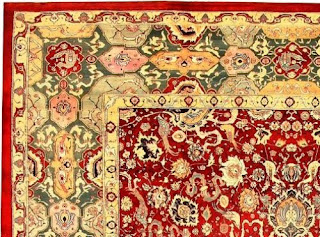Tribal and Village Rugs
These are made by women without outside supervision and
without a formal cartoon or exact design specification. The weaver will gather
together the family resources or borrow the materials to create a rug. There are
design conventions and traditions in these rugs but they are created by women
in keeping with what her family and neighbors create. They are not bound to an
exact design but copying is normal and innovation comes very slowly if at all. For instance the rugs from a village in Hamadan Province Iran will
normally fall into two style types and all the rugs of each type will look very much the same. But if we look at them over a twenty year
time frame we will see definite changes in style and color. But it is very important to note that weaving technique stay fairly constant over
long periods of time. Weaving technique will normally only change when there is some huge life changing event. Tekke Turkmenrugs stayed very consistent for hundreds of years but after they were conquered
by the Czarist Russians the rugs became increasingly finer because Russian and
Armenian traders paid more for finer rugs. The rugs stopped being an item of
Tekke Turkmen culture and started being an item of commerce.
More on Village Rugs Soon…
City Rugs
These rugs are commercial rugs made primarily for export.
They tend to be larger, sturdier, more finely woven rugs. They are useually woven from a cartoon or other design. Because of thsi City Rugs usually
have Resolved Corners while Tribal & Village Rugs rarely do.
One key clue is resolved corners.
One key clue is resolved corners.
As we can see the border
design flows around the corner which is a sign of a City Rug, The second rug has an abrupt cut off to the border design which is what we expect in
Tribal & Village Rugs.
City Rugs can be fairly crude or very refined but as a group
they are larger, tighter, heavier made then Village & Tribal Rugs. Still the
line between the two gets blurred when for instance a great Qashqai Tribal Rug
can be far more sophisticated than many city rugs. But while you are learning
the broad groups don’t get lost in the fine points of distinction.
Here are the big 6 Persian City Rugs
Here are the big 6 Persian City Rugs
Tabriz Rugs
(Turkish Knots)
Kashan
Rugs
Sarouk Rugs
Kerman
Rugs
Mashhad
Rugs
Bijar Rugs (Persian
Knots)
More on City Rugs coming soon
Link to an interesting article:
Workshop Rugs
I draw a line of distinction between City Rugs and
Workshop Rugs. It is a fine line and the distinctions blur so compare it to automobiles. Even great city rugs can be compared to a standard
Mercedes Benz, Corvette, or Cadillac. But for the most part they are mass production cars and no matter how nice one is your neighbor can go buy
one just like it (if he has the money). Then there is the hand built limited production cars such as the Bugatti Veyron Pur Sang , Jaguar XKR 75, or the Lamborghini Reventón Roadster. Much higher standards, smaller numbers and closer supervision are some of the
differences. Of course the price recognizes the exclusivity as well.
From Isfahan Workshops:
From Qum/Ghoum:
Mohammad Seirafian One of the Greatest Persian Master Workshop
Ustads
From Isfahan Workshops:
From Qum/Ghoum:
- Rashti Zadeh of Koum Also Rastehzadeh of Qum
From Tabriz (area)
Hallmarks of the Workshop Rugs.
Far higher quality control. Even though many workshop rugs are made
in
the weavers home the Usatad or master inspects regularly and maintains strict
quality control. Both city and workshop rugs use cartoons but the workshops
hire the best artists and limit use of a design. Errors and material failures
are common but in the best workshops these imperfections are not allowed.
More on Workshop Rugs coming soon





Amazing blog and very helpful. Thank you for sharing with us.
ReplyDeletePersian Carpet | Tribal Rugs Melbourne